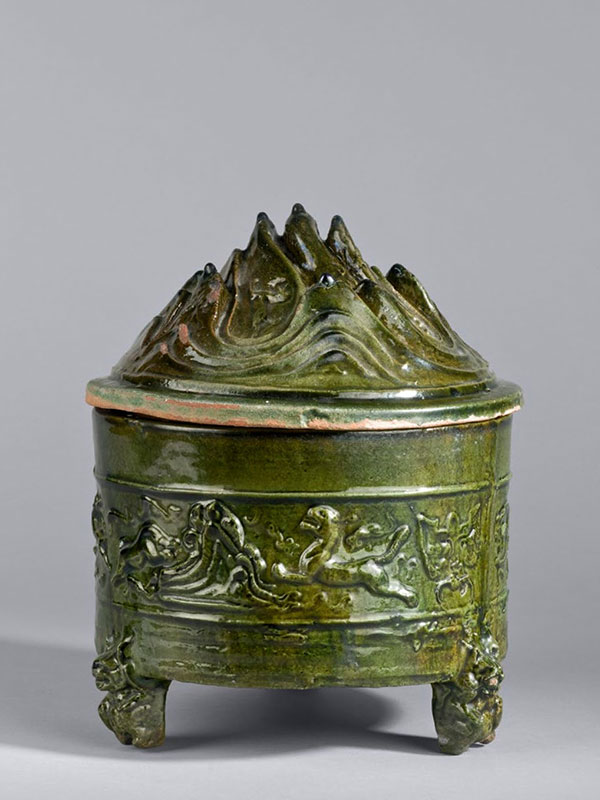Pottery tripod incense burner
A pottery covered jar, zun, of cylindrical form, supported on three moulded feet in the form of bears that rest their hands on their knees. The straight sides are evenly divided into two parts by two ridges. Each part is moulded in relief with a mock-handle in the form of a taotie mask with a ring, and applied with a procession of animal and landscape reliefs. The conical cover is modelled as a range of overlapping mountain peaks, interspersed with small cavities that hold animals. The exterior of the zun is covered in a glossy green glaze that has acquired a metallic sheen overall. The interior is covered in a brownish-green glaze. The interior of the cover is unglazed and reveals the rough, red pottery body.
The modelled animal figures and landscapes of this piece represent the Daoist ideology of the Han dynasty. The mountain-shaped lid refers to the sacred dwellings of the immortals, the Kunlun mountains, which was ruled by the Queen Mother of the West. The tiger, boar, and winged creatures and hills shown here are comparable in style to those that decorate lacquer wares and are also woven in the brocades of the period. Han dynasty pottery shapes often have parallels in metal, which is the case with this zun.[1] Krahl observes that during the Han dynasty tombs were often looted, which resulted in expensive materials such as bronze gradually being substituted by cheaper materials such as pottery, and that the poisonous lead content in the glaze would have made pieces such as this unsuitable for storage of food and drink. Because of the poisonous element in the glaze, the present jar, the shape of which is often referred to as ‘hill jar’, was more likely used as an incense burner.[2] A bronze zun of closely comparable shape and design, dated to the Western Han dynasty, was excavated from Gansu province and is now in the collection of the Gansu Provincial Museum.[3] A very similar pottery green-glazed zun, closely comparable in shape and decorative motifs, is in the collection of the British Museum.[4] Two further comparable examples are in the Meiyintang collection.[5]
PROVENANCE
Private collection, UK
- Noble Richard, N. eds. Recovering China’s Past: Art Archaeology, and Architecture of the “Wu Family Shrines,” Princeton University Art Museum, Yale University Press, New Haven and London, 2005, p. 413
- Krahl, R. Chinese Ceramics from the Meiyintang Collection, Volume One, Azimuth Editions, London 1994, page 49
- Zhongguo qingtongqi quanji, Qin Han- Vol. 12, Beijing, 1998, no. 36, p. 39
- The British Museum online collection archive, registration number: 1909,0512.29
- Krahl, R. op. cit. nos. 75 and 76, pp. 64-5

